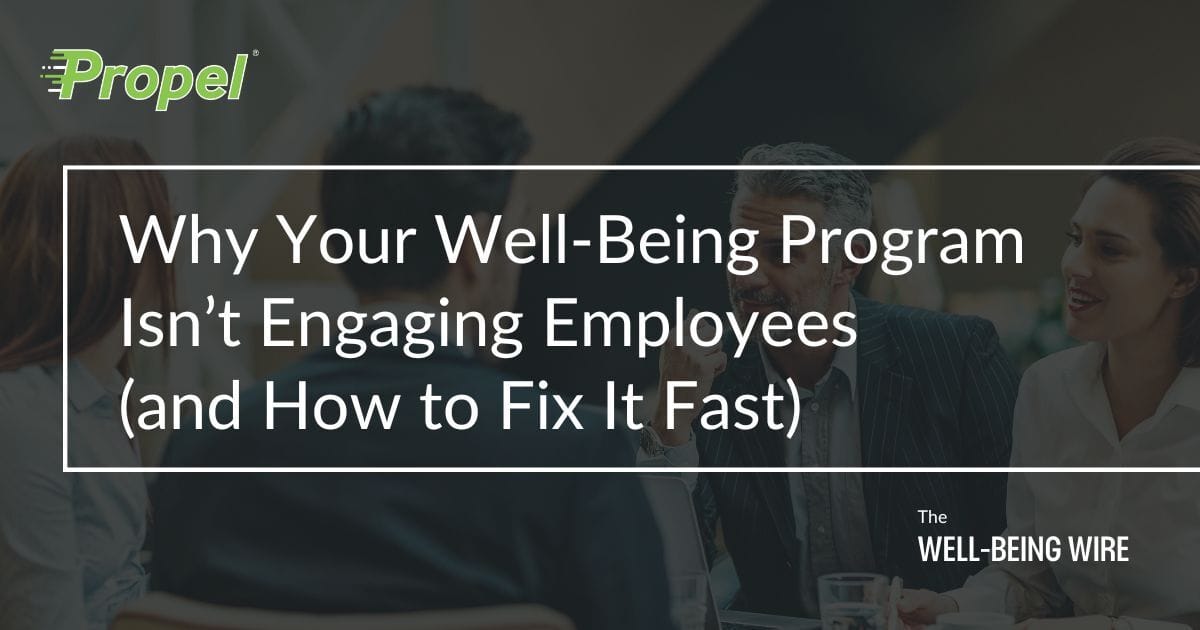Welcome to the Well-being Wire, the bi-weekly newsletter focused on practical strategies and solutions that advance well-being in the workplace.
Employee well-being programming tends to be like the wild west – it’s rarely consistent and frequently reactive.
Industry, employee traits, leadership experience, and regional dispersion cause programs to vary considerably. Nearly every organization has a unique take on what employee well-being looks like. Far too many of them lack a consistent and deliberate strategy to build a sustainable well-being program for their people.
However, the highest performing programs exhibit one or more of the following habits.
These habits have been deliberately integrated into strategic planning and have often become the cornerstone of the program’s success.
None of these habits have a direct cost, only requiring deliberate planning and thoughtful integration into the way each organization approaches well-being.
What traits do the highest performing well-being programs exhibit?
1. They are cohesive
The most effective programs know they must start at the top. They deliver a unified experience that aligns with their values as an organization. Well-being becomes directly related to how they accomplish their mission and is not in conflict with what employees know to be true about their organizational identity.
Cohesive programs prioritize clear communication and demonstrate strategic alignment. The programming doesn’t feel disjointed because it fits within a well-thought-out strategy. Employees feel comfortable buying-in because there is no dissonance between what they know to be true about their organization’s identity and what the well-being program is promoting.
Well-being that exhibits cohesion also excels in accessibility. Instead of telling employees, “Go over here for this, then go over there for that,” they make resources easy to access from a singular place. The dependability and consistency of the program improves an employee’s willingness to engage.
2. They are compelling
Good well-being programs inform. Great well-being programs inspire. Instead of simply offering information, they also inspire change by emotionally connecting with their employees. Leaders of compelling well-being programs know that information by itself often fails to motivate healthy habits. They figure out what matters to employees and try to connect on a human level.
Compelling programs use peer success as a source of inspiration. They allow employees to share their success publicly, amplifying the voice of regular employees who were successful in improving their well-being. Seeing a colleague in a similar situation succeed can be a very powerful motivator for employees, particularly if they felt they could not achieve positive outcomes due to their own circumstances.
The organizations who can successfully inspire their employees towards healthy living often do so by directly connecting the behavior to what the employee finds valuable.
We see many employers struggle with this, particularly when it comes to how their initiatives demonstrate value. A walking challenge is not as valuable for distribution center workers who are on their feet all day. However, these employees would find real value from learning how to improve their daily aches and pains through changes to their posture.
3. They are connected
The pandemic highlighted our need for a genuine community. Forward-thinking organizations have built this into the way they approach employee well-being. Community has become a central focus in their well-being programs and is often the basis for every initiative. They have created a “we’re in this together” mentality that translates to a true movement within the organization.
Connected well-being programs focus on creating true connections between colleagues through interactive and collaborative experiences. Sharing is key to the growth of their program, allowing employees to develop deeper relationships and learn from each other’s experiences.
Companies who exhibit a connected program view well-being as key to creating a sense of belonging. Employees who have shared experiences and a sense that their peers are with them on the journey towards healthier living feel a part of something much bigger than themselves, and certainly bigger than just a job.
4. They are continual
Prioritizing our well-being shouldn’t happen occasionally, it should be a continual way of living. Organizations who establish consistency in their programs see consistency in their results. Instead of running episodic initiatives, high-performing well-being programs look for ways to embed well-being in the daily routines of their employees.
Whether it’s the way a manager responds to an employee who recently lost a loved one or the foods offered in the organization’s cafeteria, daily emphasis on well-being creates an atmosphere where employees are building healthy habits continually. Well-being moves from being just a program to how employees do their jobs.
When well-being becomes continual, it also changes the way systemic challenges are overcome. Episodic initiatives may spark contemplation, but a continual focus on improving well-being leads to true changes. Leaders become much more aware of the root causes that are affecting the well-being of their employees and have more motivation to do something to solve them.
5. They are collective
A small team can only do so much to promulgate well-being within an organization. High-performing programs know this and turn well-being into a shared responsibility across the organization.
Instead of HR owning the responsibility for the organization’s well-being, leaders across the organization are tasked with doing their part. Culturally, the standard of caring for colleagues is set and employees look for ways to improve their teams.
Organizations that choose a collective approach to well-being often rely heavily on their upper and mid-level managers to lead the way. High-performing programs add incentive for managers by tying key performance indicators and objectives back to well-being. Strong programs also ask for constant employee feedback. The programming and initiatives that are prioritized do not originate from the minds of a small team, but from the concerns of the collective.
If you aren’t getting help from your well-being platform partner with instilling these habits into your well-being program, consider what Propel’s full service, customized approach could do to increase your impact and reduce your workload.
Implications for the well-being administrator:
-
The highest performing well-being programs don’t focus solely on what they offer, but how they deliver well-being in the first place.
-
Organizations that make well-being cohesive, compelling, connected, continual, and collective set themselves up for sustained success.
-
Your organization should be getting help from your well-being vendor partners to establish and strengthen these habits.
If you like this content, share it with other well-being administrators.
We’re committed to discussing challenges common to well-being leaders and presenting practical solutions that increase the wisdom of all well-being professionals.

An example of a fully customized well-being portal designed by Propel
At Propel, we create made from scratch well-being platforms that are built to fit your brand, goals, voice, initiatives, and culture.
Propel partners with our clients by providing a dedicated team that works collaboratively on a weekly basis to develop a program plan, set metrics, create custom branded communication and marketing materials, plan and implement engagement initiatives, answer questions, and provide strategic advice.
From marketing and communication strategy and execution to well-being champions programming, we design your program (not ours).
If you believe there is value in a well-being program that truly integrates your organizational culture but need strategic guidance or a team to take the workload on for you, Propel would love to help. The easiest way to get started is by scheduling a strategy session with us to discuss your program.





